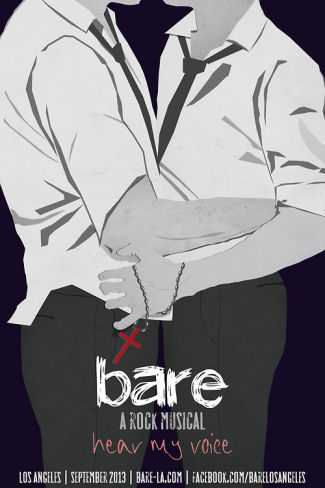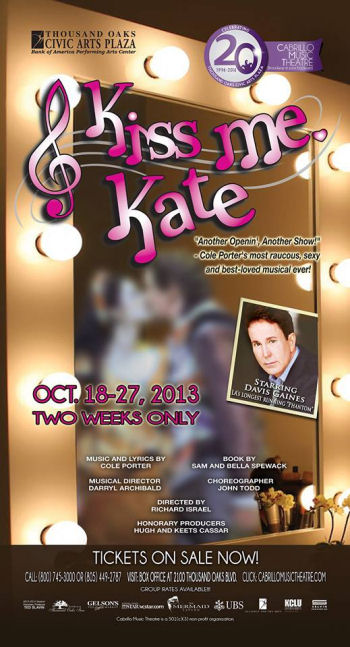
 I’ve written before about how I love to finally see musicals I’ve only heard. That’s what led to me seeing a number of new musicals such as “bare“, “Ordinary Days“, and “Burnt Part Boys” earlier this year. But sometimes it applies to older musicals as well. I’ve loved the music to “Kiss Me Kate” for years, but had never gotten around to seeing a production (part of this is because good revival productions of the musical are surprisingly rare in Southern California). That was remedied last night, at Cabrillo Music Theatre (FB) where I saw a truly outstanding production of Kiss Me Kate. In fact, it is one of the best Cabrillo productions I’ve seen in all our years of going to Cabrillo.
I’ve written before about how I love to finally see musicals I’ve only heard. That’s what led to me seeing a number of new musicals such as “bare“, “Ordinary Days“, and “Burnt Part Boys” earlier this year. But sometimes it applies to older musicals as well. I’ve loved the music to “Kiss Me Kate” for years, but had never gotten around to seeing a production (part of this is because good revival productions of the musical are surprisingly rare in Southern California). That was remedied last night, at Cabrillo Music Theatre (FB) where I saw a truly outstanding production of Kiss Me Kate. In fact, it is one of the best Cabrillo productions I’ve seen in all our years of going to Cabrillo.
If you hadn’t figured it out from the title, Kiss Me Kate is a musical retelling of William Shakespeare’s The Taming of the Shrew. Before I relate a little history of the musical, let me gush a bit about Taming, which is one of my favorite Shakespeare plays (the other is Two Gentleman of Verona, which I know best from the 1970s musical). I’ve seen a number of incarnations of Taming — from the perfect version of Taming done as an episode of Moonlighting back in the 1980s to Shakespeare in the Park to another version this summer at Theatricum Botanticum. The retelling in this musical — while not capturing all the elements of the original — captures many of the key elements and language, and is a hoot to watch.
As for the musical itself: Kiss Me Kate has music and lyrics by Cole Porter, and a book by Sam and Bella Spewack. Cole Porter was one of the most prolific and popular composers of his day. However, he had had a major horse riding accident in 1937 that resulted in the amputation of left leg. This affected his creative output generally, and by the mid-1940s he was dealing with depression. He was talked into writing Kiss Me Kate, and it went on to be one of the most successful musicals of the day. In fact, Kiss Me Kate won the first Tony award for best musical in 1949.
The conceit that makes this musical successful is that it is not just a musical version of Taming. It combines a musical Taming with a backstage story of the actors putting on a production of Taming in Baltimore. The backstage story mirrors the on-stage story: The leads of Taming: Katharine and Petruchio, are played by Lilli Vanessi and Fred Graham. Lilli and Fred have an equally tempestuous relationship and are currently both in love with each other and divorced from each other. Similarly, there is in offstage relationship between the secondary couple, Bianca (Lois Lane) and Lucentio (Bill Calhoun). The secondary relationship (played, as many secondary relationships were in shows of that day, for comic effect) is complicated by the fact that Lois sleeps around, but loves Bill… and Bill can’t stop gambling. In fact, Bill has recently incurred a $10,000 gambling debt from some local gangsters and signed the IOU… as Fred. Complicating all this is that Fred is trying to woo Lois and sends her flowers and a card before the show. However, these flowers and card are delivered to Lilli, who interprets the flowers as anniversary flowers and doesn’t read the card… until during the show. At this point the real shrew comes out, and the fur flies! In some ways, Lilli’s reaction during shrew brings in a some elements of a farce, and the reaction to her ad-libbed fighting makes the Taming scenes all the more fun.
Are there book problems? A few minor ones that show up only in retrospect — that is, when you compare Kate to modern musicals. A number of the songs are more like 1930s musicals in that they have no connection to advancing the plot. This was the pre-Oklahoma style that Porter grew up with. A number of scenes take place infront of a dropped curtain solely to allow scenery changes. These two combine in this show with the number “Brush Up Your Shakespeare”, which is clearly a killing time novelty number. But it’s fun… so no one cares. Similarly, the wonderful number “Too Darn Hot” adds absolutely nothing to the story other than a wonderful dance number… but this was common for musicals of the day (you’ve got similar numbers in Damn Yankees and The Pajama Game). Again: so much fun, and no one cares with that dancing and that music.
So you’ve already got a winning basic story, and a winning conceit and wraparound story. Now add to this all the glorious Porter songs from this show that have become standards — I can’t think of a single one that hasn’t had strong popular play, except perhaps “From This Moment On”. This is what Cabrillo started with — great story, great music. What turned the Cabrillo production into something spectacular was the execution, which was perfect.
In discussing the execution, I’m going to start someplace I normally don’t start — with the musical side. A credit is not provided for the orchestrations here (I’m guessing they are based on the 1999 Broadway Revival), but they were wonderful — clear, crisp, energetic, bright, sparkingly. If you only knew this show from the cast album of the 1948 shows, you’ll be blown out of your seats. Credit here should likely therefore go to the 1999 musical team: orchestrations by Don Sebesky; dance arrangements by David Chase; under the 1999 musical direction of Paul Gemignani. However, I think more credit here goes to the Cabrillo team that executed that design: Darryl Archibald (FB) as musical director and Lloyd Cooper (FB) as associate conductor and assistant musical director. The orchestra assembled by Darryl Tanikawa (FB) was also excellent and a delight to hear in these days of small efforts. It featured Darryl Archibald (FB) as conductor, and consisted of Gary Rautenberg (FB) [Flute I, Piccolo, Clarinet, Alto Sax I], Darryl Tanikawa (FB) [Clarinet I, Alto Sax II], Ian Dahlberg (FB) [Oboe, English-Horn, Tenor Sax, Flute, Clarinet], Darrin Smith [Bassoon, Bariton Sax, Clarinet, Flute], Bill Barrett [Trumpet I, Flugelhorn, Piccolo Trumpet], Chris Maurer/FB [Trumpet II, Flugelhorn, Piccolo Trumpet], June Satton [Trombone, Bass Trombone], Melissa Hendrickson [Horn], Sharon Cooper [Violin I – Concertmaster, Mandolin], Sally Berman [Violin II, Mandolin], Marisa Mcleod [Viola], Rachel Coosaia (FB) [Cello], Lloyd Cooper (FB) [Piano, Keyboard Synth I], Bill Fulton [Keyboard Synth II], Shane Harry [Electric & Acoustic Double String Bass], Michael Deutsch [Percussion] and Alan Peck [Set Drums]. Particularly noteworthy was the trumpet performance of Bill Barrett (at least I’m guessing it was Barrett) onstage during “Too Darn Hot”. But during a number of songs the quality of the orchestral team was apparent — they were just great.
Of course, the on-stage team was no slouch either. Under the perfect direction of Richard Israel (FB), and dancing their feet off with the choreography of John Todd (FB), the acting team also blows you away. Again, I’m particularly noting the directing and choreography team here, because I kept noticing all the small things going on in the background during performances that made this special. This was particularly noteworthy during “Too Darn Hot”, but was in other numbers as well. There was so much going on you need to see this show multiple times to catch it all — but today is the last performance. The team of Israel and Todd brought out the fun in these actors and they just had fun with their characters — and this came across wonderfully on stage. This is what I absolutely love to see — and it is something you don’t get in the movies — performers infused with the joy of performing and their characters, and this joy just infecting and reflecting to the audience.
OK, OK, but what about the actors. In the lead positions were Davis Gaines (FB) as Fred/Petruchio and Victoria Strong (FB) as Lilli/Kate. We’ve seen both many times – Gaines most recently in Silence! , and Strong many years ago in Light in the Piazza. Both were perfect in these roles and brought a dynamism and energy that was spectacular. Both also brought wonderful voices. I particularly enjoyed pulling out the binoculars and watching the faces of these two — they were having such delight and fun with their roles. Just a joy to watch. They had so many strong numbers it is hard to single them out, but I particularly remember Strong taking no prisoners in “I Hate Men” and Gaines in “Where Is The Life that Late I Led”, although they were also great in their joint numbers.
As the secondary couple, Scott Reardon (FB) (Bill/Lucento) and Reba Buhr (FB-Actor, FB) (Lois /Bianca) were no slouches either. We’ve seen both before as well — Reardon as Dauntless in Once Upon a Mattress and Buhr as Sally in You‘re a Good Man, Charlie Brown (one of the best things about that show). Both sang well and performed well, especially in numbers such as “Bianca” (Reardon) and “Always True to You in My Fashion” (Buhr).
Also noteworthy were the two gangsters (a common comedy theme in musicals, which was spoofed in The Drowsy Chaperone): Tom McMahon (FB) and Steve Greene (FB). These two had their main number in “Brush Up Your Shakespeare”, but performed their comic relief role well throughout the production.
In terms of smaller roles, there was the lovely black lady who played Lilli’s dresser (I’m guessing this was Raquel Jeté (FB) as Hattie) and Lamont Whitaker (FB) (Paul), who just shone throughout “Too Darn Hot” and in other small roles. The remainder of the cast is harder to single out primarily because their roles aren’t as strongly identified to the audience in the script. However, a number stand out in my memory even if I don’t know what to call their characters. There was one member of the ensemble who was doing cartwheels in one number and in general bouncing and bounding around — she was just a joy to watch. There were also two larger members of the ensemble who had such joy of movement and stage presence that they just drew your eye (and kudos to the casting director for casting an ensemble of all shapes and sizes, as opposed to the model size of the day). I also remember the dancers during the grape stomping number in Act II — again, these young women were just exuding such fun. The athletic energy and joy of the ensemble was just great. The remaining performers were: Steve Perren (General Howell), Ronald Rezac (Harry/Baptista), Orlando Agawin (FB) (Ensemble), Francesca Barletta (FB) (Ensemble), John Paul Batista (FB) (Riley/Hortensio), Michael Byrne/FB (Flynt/Gremio), Danielle Campbell (FB) (Ensemble), Allen Darby/FB (Ensemble), Martin Feldman/FB (Pops/Ensemble), Jay Gamboa (FB) (Ensemble), Lexi Greene (FB) (Ensemble), Abigail Herman (FB) (Ensemble), Natalie Rose Iscovich/FB (Ensemble) [and the daughter of someone I went to camp with], Kurt Kemper (FB) (Ensemble), Anna Lamonica/FB (Ensemble), Tellina Lee (FB) (Ensemble), Derek A. Lewis/FB (Ensemble), Timothy Reese/FB (Ensemble), Shelly Regner (FB) (Ensemble), Tracy Ray Reynolds (FB) (Ensemble), Harry Schantz (FB) (Ensemble), Joey Sponseller (FB) (Ensemble), and Megan Stronger/FB (Ensemble).
Turning to the technical side of things. The sets were provided by Gateway Playhouse (FB) in Bellport NY and worked quite well. I was particularly taken by the sets for the Taming side of things, which reminded me of the other productions of Taming that I have seen. Costumes were provided by A. Jeffrey Schoenberg (FB) and were quite well done. I particularly appreciated the homage to the original 1948 costumes on the Taming side of things (as opposed to realistic costumes), and period costumes used in the backstage scenes. I also applauded the costumes during Act II, Scene 8 — in particular the use of hosiery for the grape stompers (Christine Gibson was the wardrobe supervisor). The hair and makeup design of Cassie Russek (FB) was strong, especially considering the abuse that it took. Sound was by regular Cabrillo sound designer Jonathan Burke (FB) and was excellent as usual; the lighting by Rand Ryan worked well to establish the mood and didn’t have an obvious overuse of spots (a Cabrillo problem many years ago). Gary Mintz was the technical director. There was a new face as production stage manager: Brooke Baldwin/FB, assisted by Susie Castillo/FB. Another changing of the guard in that position? (First Lindsay, then Allie, now…). Cabrillo Music Theatre (FB) is under the artistic direction of Lewis Wilkenfeld (FB).
The last performance of “Kiss Me Kate” is today at 2pm. Given when I’m finishing this writeup, you have about an hour or so to get there and get tickets. So get moving — what are you waiting for? You can purchase tickets online. Cabrillo’s next show is “Forever Plaid” at the end of January (this will be our third visit with the Plaids — fourth if you count Plaid Tidings).
Dining Note: We discovered a new Japanese restaurant — Nori Japanese Grill (menu), which is in the same center with Lassens Natural Foods. Nothing fancy in terms of the restaurant itself — you order at a counter and they bring it to the table. However, the food itself was excellent both in terms of quality and presentation. Quite a surprise, and I think we’ll be back there.
[Ob. Disclaimer: I am not a trained theatre critic; I am, however, a regular theatre audience. I’ve been attending live theatre in Los Angeles since 1972; I’ve been writing up my thoughts on theatre (and the shows I see) since 2004. I do not have theatre training (I’m a computer security specialist), but have learned a lot about theatre over my many years of attending theatre and talking to talented professionals. I pay for all my tickets unless otherwise noted. I believe in telling you about the shows I see to help you form your opinion; it is up to you to determine the weight you give my writeups.]
Upcoming Theatre and Concerts: November starts with “Dirty Rotten Scoundrels” at Actors Rep of Simi (FB). That will be followed by a visit with Thomas the Tank Engine when we volunteer at OERM over Veterans Day. The third week will be theatre-ish, as we attend ARTS’s Nottingham Village (FB) (a one-weekend ren-faire-ish market — tickets are now on sale), as well as seeing the Trollplayers (FB) production of Steven Schwartz’s “Children of Eden” (which runs November 8-17) [Trollplayers is the community theatre group at Our Lady of Lourdes Church in Northridge]. That weekend will also bring a release party for a Kickstarted-CD by Big Daddy. The weekend before Thanksgiving is also very busy with three shows: Tom Paxton (FB) in concert at McCabes Santa Monica (FB) on Friday; “Play It Again Sam” at REP East (FB) on Saturday, and the rescheduled “Miracle on S. Division Street” at the Colony Theatre (FB) on Sunday. Thanksgiving weekend is currently open, as is much of December (December is due to the Annual Computer Security Applications Conference (ACSAC) in New Orleans, which has me out of two the first two weekends in December… but has me wondering about New Orleans theatre), but should bring “The Little Mermaid” at Nobel Middle School, and “Peter and the Starcatcher” at The Ahmanson Theatre. Looking into January…. nothing is currently scheduled, but it will likely bring “I Love You, You’re Perfect, Now Change“, which is the first show of the REP East (FB) season, running 1/17 through 2/15/2014… and the end of the month will bring “Forever Plaid” at Cabrillo Music Theatre (FB). Of course, we look forward to seeing you at ACSAC for the wonderful training opportunities there. As always, I’m keeping my eyes open for interesting productions mentioned on sites such as Bitter-Lemons, Musicals in LA and LA Stage Times, as well as productions I see on Goldstar, LA Stage Tix, Plays411.



 I had set aside this weekend for Carrie – The Musical. Alas,
I had set aside this weekend for Carrie – The Musical. Alas, 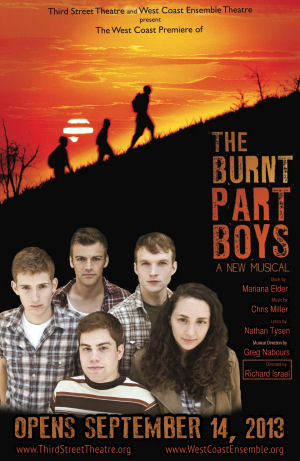
 Journeys and hills. That’s a good characterization of yesterday. We journeyed over a hill yesterday afternoon to celebrate
Journeys and hills. That’s a good characterization of yesterday. We journeyed over a hill yesterday afternoon to celebrate 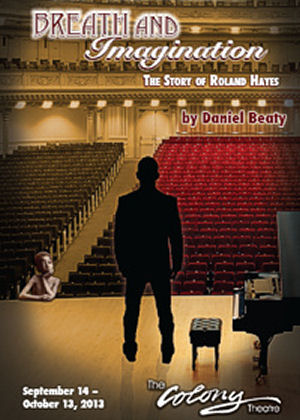
 Exploring a life on stage. This is a common theme in the theatre, especially if the life is an interesting one. It was the theme of
Exploring a life on stage. This is a common theme in the theatre, especially if the life is an interesting one. It was the theme of 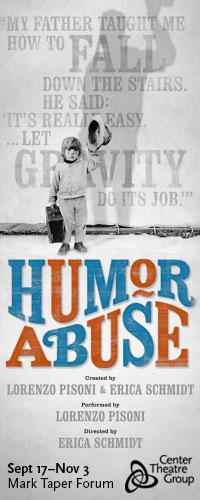
 Yesterday, when I got to work, I was confronted with the news that
Yesterday, when I got to work, I was confronted with the news that 
 Back in Spring 2011, we missed seeing
Back in Spring 2011, we missed seeing 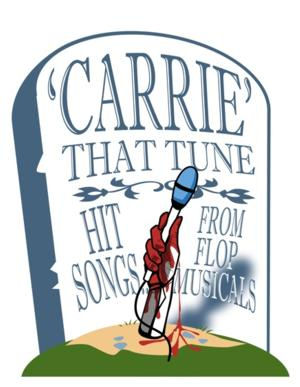
 There once was a song that went “There’s just no tune / as exciting / as a show tune / in two-four”. That song was written by Jerry Herman for the musical revue “Parade” in 1960. The musical went nowhere; the melody, however, was recycled into “It’s Today” from the musical Mame. It is an example of how many songs from failed or unknown musicals later went on to become hits… or at least were surprisingly good. I could give you many more examples, such as the Bobby Darin hit “Artificial Flowers”, which came from the musical Tenderloin. This notion — of spectacular songs from less-than-spectacular musicals — was the driving notion from the musical revue “Carrie That Tune” was saw last night at the
There once was a song that went “There’s just no tune / as exciting / as a show tune / in two-four”. That song was written by Jerry Herman for the musical revue “Parade” in 1960. The musical went nowhere; the melody, however, was recycled into “It’s Today” from the musical Mame. It is an example of how many songs from failed or unknown musicals later went on to become hits… or at least were surprisingly good. I could give you many more examples, such as the Bobby Darin hit “Artificial Flowers”, which came from the musical Tenderloin. This notion — of spectacular songs from less-than-spectacular musicals — was the driving notion from the musical revue “Carrie That Tune” was saw last night at the 